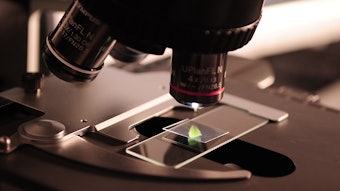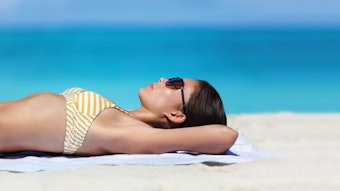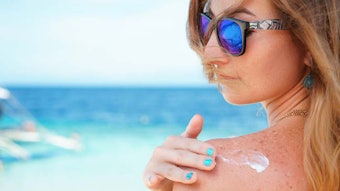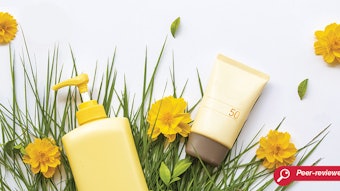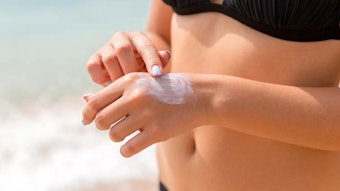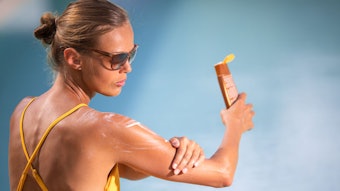In June of 2011, the U.S. Food and Drug Administration (FDA) published its report, Revised Effectiveness Determination: Sunscreen Drug Products for Over-the-counter Human Use, 21 CFR part 201.1 This stated, “The record does not currently contain sufficient data to indicate that there is additional clinical benefit above SPF 50.” However, the FDA invited submissions for data demonstrating the contrary. In response, this author submitted test data showing that a group of four commercial products with SPFs between 70 and 85 protected individuals better than a group of four commercial products with SPFs from 50 to 55.2
By definition, the FDA’s clinical method1 to test sunscreens indicates an SPF of 100 requires twice as much erythemal UV energy as an SPF 50 to produce the same effect. Yet many argue there is no clinical difference between the two, and that consumers are equally protected by either. In fact, as this article was written, an Internet search for “What SPF is needed?” retrieved three articles in which dermatologists stated: 1. The difference in UVB protection between an SPF 100 and SPF 50 is marginal; far from offering double the blockage, SPF 100 blocks 99 percent of UVB rays, while SPF 50 blocks 98 percent. (SPF 30, that old-timer, holds its own, deflecting 96.7 percent).3 2. It is logical for someone to think that an SPF of 30 is twice as good as an SPF of 15, and so on, but that is not how it works;4 and 3. Actually, an SPF 70 doesn’t protect you that much better than a SPF 30.5
Although these absorbance figures are correct, stating there is little difference in protection could be no more incorrect. What is most important is the amount of UV that transmits through the product; i.e., the amount that reaches the skin. If an SPF 30 allows 3.3% of erythemal energy to reach the skin while an SPF 60 only allows 1.7%, essentially, twice the amount of erythemal energy reaches the skin with an SPF 30 than an SPF 60.
Ostensibly, every commercial product tested in a laboratory setting shows that it takes X times more energy to produce mild erythema on protected skin than on unprotected skin; where X is the SPF of the product tested. Yet, the FDA questions if there is a need for SPFs higher than SPF 50. And dermatologists, quoted previously, continue to state there is no difference between an SPF 30 and SPFs over 50. In order for the FDA and proponents claiming that higher SPFs are not needed to be correct, there are only two reasonable explanations: Either the clinical test is not accurate or there is insufficient energy in natural sunlight to produce a reaction in skin that is protected by an SPF 30 or 50.
Remarkably, little evidence actually exists showing that SPF values obtained by solar simulators are comparable to those that would be obtained in natural sunlight. In 1978, Sayre et al. published studies on a very low SPF product6 and concluded that the results were comparable, although it appears to this author that there may have been significant differences in the results, with the value obtained in natural sunlight being significantly lower. In the interim, a few studies have shown that different values are obtained depending on the specifications of the solar simulators.7–9 The primary goal of the two studies referenced herein was to determine if there were measurable differences between an SPF 100 product and products of SPF 50 or lower.
Materials and Methods
Institutional review board approvals were first obtained to carry out each test, which took part in outdoor settings and on two separate occasions. Three commercial sunscreen products with SPF levels of 30, 50 and 100 were used in the first test, and the same SPF 50 and 100 products were used in the second test—in addition to an SPF 45. The actives in the products are shown in Table 1.
Ten fair-skinned Fitzpatrick Types I and II individuals, whose upper front thighs had little or no sun exposure, were recruited for each test. Four 12 x 7-cm areas were delineated—two on each thigh, with approximately 3 cm separating each site. The commercial products were applied to three of the sites, while one site was left untreated as the control. The products were blinded to the study investigators and double-blinded to the grader; for the first test, products labeled A, B and C were applied, and for the second test, products labeled B, E and G. All products were applied to one of the three sites at a rate of 2 mg/cm2. The application site was systematically varied so that no product would be disproportionately located in the same area.
The subjects were moved to a shaded area during a minimum 15-min product drying time. All were seated, and any of their exposed skin was either covered or protected with an SPF 100 sun care product; subjects were also required to wear hats and sunglasses. In addition, the 12 x 7-cm product sites were overlaid with a flexible covering that had 10 x 5-cm openings corresponding to the 12 x 7-cm product sites to ensure that the edges were protected.
Both tests took place in Ormond Beach, Florida; the first on Sept. 24, 2012 (late summer/early autumn in the U.S.), and the second on July 9, 2013—midsummer. For test one, at 11:55 a.m., the shade was removed so subjects were exposed to approximate midday sun. For the second test, the shade was removed at 12:03 p.m.
First test: Erythemal readings were then taken every 15 min using a radiometer equipped with a calibrated outdoor detectora. MEDs per hour were recorded as well as accumulated MEDs at 15-min intervals. After two hours and 4.925 MEDs, at 1:25 p.m., one-half of each product-protected site was covered with opaque tape and the other half remained exposed for one additional hour—for a total of 7.21 MEDs. One-half of the unprotected site was covered after 0.5 MED, and the other half was covered at 1.0 MEDs.
Second test: The same detector was used to record erythemal readings and UVA energy every 5 min. The unprotected sites were uncovered at 12:37 p.m. and recovered at 12:52 p.m., after a 1 MED exposure.
At 2:55 p.m. for the first test and 2:03 p.m. for the second, the tests were complete and all subjects were moved indoors. Participants were instructed to return in approximately 24 hr, to avoid additional sun exposure, and to not apply any products to the test areas. The next day, all subjects returned and were graded by independent, skilled investigators who took no part in the first day’s activities. For the first test, the grading scale was as follows: - no change, + minimal erythema, ++ moderate erythema and +++ severe erythema.
For the second test, a 0-5 numeric scale was used: 0 = no response; 1 = minimal erythema or tan response, not necessarily over entire test site; 2 = minimal erythema or tan response over entire test site; 3 = moderate erythema or tan response over entire test site; 4 = considerable erythema or tan response over entire test site; and 5 = intense erythema or tan response over entire test site.
Results
First test: Table 2 shows the MED and accumulated MED readings in 15-min increments, whereas Table 3 illustrates the grades obtained for each subject for each product or unprotected site. Note that “?” was not listed as a possible score in the protocol, but was added when the grader was not sure whether there was an erythemal response. In the final analysis, a “?” was graded as no response. Figure 1 is a photo of Subject 2’s right leg, illustrating erythema on both sites. The upper box was the unprotected site, and the lower site was the SPF 50 site. Table 4 estimates the SPF based on the erythemal energy at the product sites, divided by the same grade on the unprotected site.
The SPF 30 product was graded as having a lower SPF on eight of the subjects but tied for highest on one subject, when compared with the SPF 50 and SPF 100 products. One subject exhibited no response on all sites, protected or unprotected. The SPF 50 and 100 exhibited similar protection, and essentially could not be differentiated in this test. At 0.5 MEDs on the unprotected site, 7/10 subjects had responses and at 1.0 MEDs, 9/10 subjects exhibited responses. One subject had no response.
Second test: Table 5 displays the MED and accumulated MED readings in 5-min increments, the UVA readings in mw/cm2, as well as temperature, relative humidity, wind speed and comments. Table 6 illustrates the grades obtained for each subject with each product or unprotected site. Figure 2 is a photo of Subject 7’s right leg, illustrating erythema in both sites. The upper box was the unprotected site and the lower site was the SPF 45 site. To the left of the top location, the SPF 100 was applied. In this case, one grader scored the observed erythema as a “1” and another grader scored it as “0.”
Discussion
The term MED is used throughout this article, and its context is based on the theoretical amount of UVB and UVA energy needed to create a minimum sunburn on an “average” Type II skin. This amount of energy is theoretically 21 mJ/cm2 of erythematically weighted energy. The radiometer data reported here is based on this theoretical calculation, and is not the amount of energy needed to produce minimal sunburn on any individual subject involved in the test.
First test conditions: On the first test date, the weather was relatively clear with a few high and thin clouds, and temperatures were in the low to mid 80°s F (~ 26.7°C). The three-hour test resulted in total accumulated MEDs of 7.21. This three-hour time frame was chosen for two reasons. First, three hours was believed to be the maximum length of time a sunscreen user would remain in the same position. Second, when a high SPF, “Very Water Resistant” product is tested via the FDA method, considering the steps involved, it is approximately three hours after product application when the subject is finally exposed to UV light.
This three-hour timing seems to conflict with the FDA’s required labeling, which directs users to reapply sunscreen after two hours. However, per the FDA test protocol,1 an SPF 50 would be applied and allowed to dry for 15 min minimum before the subject goes into an 80-min water rotation. Then, those 80 min in the water are interspersed with three 15-min periods out of the water. This means that 140 min have passed since the product was applied. After the final period in the water, the subject is allowed a 15-min drying time before being irradiated.
The irradiation time for an SPF 50 with a subject that has a 10-sec MED—which is a good average for a fair-skinned subject being tested with a high intensity, single port solar simulator—means the entire radiation time would require 2,500 sec or about 40 min. Adding this all up means the initial irradiation sub site was irradiated at 155 min after application, and the last at about 195 min after irradiation. Further, this example is probably an absolute optimum situation, and in reality, the irradiation time is going to be even longer after the product application.
Second test conditions: On the second test date, the weather was mostly clear with a few high, thin clouds and temperatures in the mid 80°s F (~ 26.7°C). The relative humidity was around 63%, and wind speed was about 10 mph throughout the test. The total 2-hr test resulted in total accumulated MEDs of 7.88.
Note that Ormond Beach, Florida, is located at approximately 29.5 degrees north latitude, so on the first test date, Sept. 24, the sun tracked very close to the equator, meaning at solar noon, the sun angle was at approximately 29.5 degrees; less at any other time during the test. The erythemal intensity varied from about 1.7 to 2.7 MEDs/hour during the test period. At other times during the typical sunbathing season, the sun could be much more intense. The total MEDs for the two-hour portion of the test were 4.9, and for the three-hour portion, 7.2; these are relatively mild. In fact, 7 to 8 MEDs in mid-summer could easily be experienced in a two-hour period, and 10 MEDs in a three-hour period.
On the second test date, July 9, the sun tracked at about 23 degrees north latitude, meaning at solar noon during the test, the sun was at approximately a 6.5 degree angle. This, and the fact that the sky during the test time was relatively clear with only a few clouds, resulted in fairly intense UV radiation. The MED/hr varied from about 2.2 to 5.27.
Conclusions
Several things can be concluded from these tests. From the first test, it is clear that fair-skinned individuals react much quicker to natural sunlight than one full theoretical MED; in fact, seven out of 10 subjects responded at 0.5 MED. Also, an SPF 30 does not offer complete protection to fair-skinned users. Eight of the 10 users responded at 2 hr after 4.9 theoretical MEDs of natural sunlight exposure, so the labeled SPF 30 in natural sunlight based on this test would best be characterized as equal to or less than 10.
In addition, the SPF 50 and SPF 100 products performed measurably better than the SPF 30 product but neither offered complete protection, even at 4.9 theoretical MEDs. Although there appeared to be significant variation, a good estimate of the SPF of the two products would probably be 15-20. However, it could not be concluded that the SPF 100 performed better than the SPF 50. Further testing at higher exposure levels was thought to be needed to make this determination, thus providing the rationale for the second test to be conducted in a more intense natural sun setting.
In the second test, the zinc and titanium SPF 45 product was added to determine if the mineral sunscreen actives produced better or different results. When all of the grades were totaled and averaged, the SPF 100 grade averaged 0.9; the SPF 50, 1.2; and the SPF 45, 1.8. The unprotected grade also averaged 1.8, meaning the unprotected site receiving 1 MED had the same score as the SPF 45 that received 7.88 MEDs. Thus, it is easily estimated that the SPF 45 tested approximately the same as an SPF 8 in natural sunlight on the test date with these subjects. The SPF 100 and SPF 50 offered more protection, although an actual value could not be assigned. The SPF 100 exhibited the greatest degree of protection.
The second test confirmed that light-skinned individuals react to UV energy prior to receiving one full theoretical MED, as defined in this article. The SPF 100 product offered superior protection to the SPF 50 product, and far superior to the SPF 45 and SPF 30 product—although none offered complete protection in natural sunlight. Further, it can be concluded that there is no justifiable reason for the FDA to limit SPF levels to 50. The SPF 45 and the unprotected sites had the same average grade, 1.8, meaning the actual SPF in this test period in natural sunlight was about 8.
As has been previously been reported, there appears to be a significant difference in the protection predicted by clinical testing with a solar simulator operating at intensities much greater than natural sunlight. Further testing is necessary to determine why this is true. The present method of clinical testing for SPF is certainly imperfect, but it does appear to rank products correctly. However, the labeled SPF has the potential to suggest to users that they can stay out X times longer, with X representing the SPF.
References
Send e-mail to [email protected].
1. US Food and Drug Administration, Revised effectiveness determination: Sunscreen drug products for over-the-counter human use, Federal Register 76(117) (Jun 17, 2011)
2. Comment, FDA-1978-N-0018-0704, Lott Research, Inc. (Aug 31, 2011)
3. C Saint Louis, Confused by SPF? Take a number, available at www.nytimes.com/2009/05/14/fashion/14SKIN.html (Accessed Jun 28, 2013)
4. Popsugar Fitness, available at www.fitsugar.com/Do-You-Really-Need-SPF-100-Sunscreen-3150355 (Accessed Jun 28, 2013)
5. D Dador, How much SPF do you really need? available at abclocal.go.com/kabc/story?section=news/health&id=6740746 (Accessed Jun 28, 2013)
6. R Sayre, D Desrochers, E Marlowe and F Urbach, The correlation of indoor solar simulator and natural sunlight, Arch Derm 114, 1649–1651 (1978)
7. R Sayre, J Stanfield, A Bush and D Lott, Sunscreen standards tested with differently filtered solar simulators, Photo Derm, Photo Immun and Photo Med 17, 278 -283 (2001)
8. B Uhlmann, H Gers-Barlag, D Alert and G Sauermann, Consequences for sun protection factors when solar simulators spectra deviate from the spectrum of the sun, Intl J Cos Sci 18 13–24 (1996
9. A Young et al, A sunscreen’s labeled sun protection factor may overestimate protection at temperate latitudes: A human in vivo study, Soc Invest Derm 130 2457–2462 (2010)








